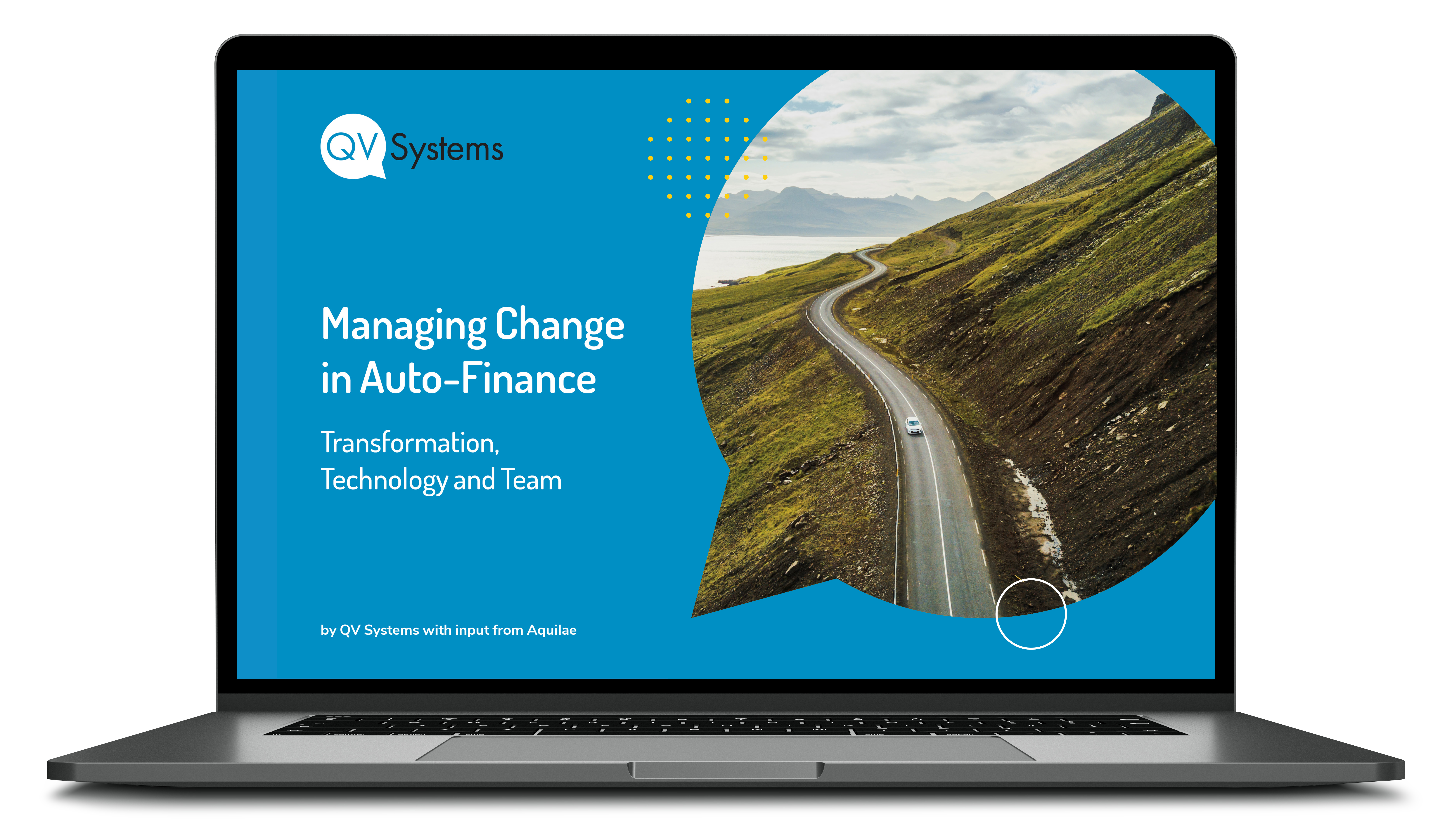This guide was produced in partnership with auto-finance consultancy Aquilae based on a shared interest in the future of the industry, with both parties contributing impartially. This guide does not constitute an endorsement of Aquilae's services by QV Systems, nor an endorsement of QV Systems by Aquilae.
The fleet industry is undergoing massive change, driven by new trends in market conditions, vehicles, and customer expectations.
Much of this is due to the evolution of technology, accelerated by the events of 2020. In the face of disruption, 50% of fleet managers adopted new tools to boost efficiency in the last year alone. Meanwhile, electric vehicle use among business customers surged 144% in 2020.
This is putting increasing pressure on fleet managers and OEMs to transform their processes to meet consumer demand and stay competitive in a fast-evolving market. However, to maximise the impact of transformation, fleet managers must take a holistic approach.
The growth of digital tools in fleet management is a huge opportunity to increase efficiency, service and retention among your customers. To reach its full potential though, any change in technology must be matched with a corresponding evolution in your team.
Investing in new tools without updating the human element of your business at best neutralises possible gains, and at worst will leave your business in a weaker position than before. By bringing your team into the change process, however, you set your business up for success.
This starts with the four fundamentals underlying your team's performance: Clarity, Capability, Purpose and Culture.
This guide was created in partnership with independent auto-finance consultancy Aquilae, contributing their guidance on how better team management and development can help your business achieve its goal. We'll show you how to manage transformation across your teams and technology-stack to create a more efficient, customer-focused business. These are the core pillars of a modern, agile auto-finance business and are essential to remain competitive within this fast-changing industry. With the right tools and processes, not only can you help your staff to reach their full potential in their work and client interactions, but you'll set your business up for long term success.
Clarity
Picture yourself in an “All Hands” meeting. The whole company is assembled, in person or virtually, and your CEO is updating you all. He describes forthcoming new products, how construction of the new manufacturing facilities is progressing and the rationale for a recent acquisition. The sense of energy and excitement is palpable. The assembled “hands” hang on every word.
Then comes the Q & A. Your CEO candidly answers questions on the new developments. One of your colleagues introduces a new topic. He asks, “How are plans progressing to colonise other planets?” There’s a hush, a few laugh nervously, many smile but absolutely everybody leans in with rapt attention to hear their leader’s answer, which is delivered with the same respect as before. His response is deeply informed, candid, entirely serious but not lacking in humour.
Now imagine how that brief exchange in front of the whole company recalibrates the audience’s belief in what is possible and the extent to which they are expected to think and deliver big. This is an example of improving clarity
Clarity is one of the four fundamentals that influences performance.
It can be summarised by the question, “How clear are you about what you are supposed to be doing?” It’s a question that is as relevant to the CEO and the leadership team as it is to the most junior member of staff.
Aquilae was recently deeply involved in a project to introduce a new car usage concept into the UK. Changes in consumer behaviour, developments in technology and availability of investment are leading disruptive new entrants into all walks of life, including the automotive finance and leasing sector. Like our potential space colonisers above, these new entrants exhibit similar belief, enthusiasm and a sense of adventure. The most optimistic of us would concede that there will be challenges to building new civilisations on other planets, and similarly, although hopefully on a lesser scale, there will be challenges in introducing new ways for people to choose and use cars.
Holiday cottages and people’s spare bedrooms have a reassuring tendency to remain in one place. They have few moving parts and for the most part don’t depreciate. Disrupting how we find, reserve and pay for them benefits from these attributes. By contrast, cars are designed to be mobile, have many moving parts, require maintenance and for the most part depreciate. In short, there is a significant “analogue” component to managing fleets that needs to be married successfully with any digital transformation for the full benefits to be felt. It became apparent quite early during our project that, when it comes to cars, providing customers with the services and user experience that they are embracing for other aspects of their life is going to require a blurring of the existing lines between retail and fleet. It is also going to depend on successfully linking together both analogue and digital components. By making your goals clear, you open the door to project success.
Asking the right questions
Historically, standards for service would be set by the providers and customers would have to comply, but the advent of digital technology has changed all that. Expectations set in one industry – financial services or travel, for example – now bleed into other business services. Consumers now expect the same convenience, control and flexibility across all their interactions.
This means that any change in your business must start with the question: ‘How clearly do you understand what your customers want?’. Answering this has become significantly harder in recent years, as expectations and technology have evolved rapidly. In this new scenario, business purpose is not a static goal, but one that must be in constant conversation with the market.
The first challenge for many businesses is getting a clear view of the current state of their processes and their opportunities for change. Often, years of siloed teams and technology procurement strategies have left them with a range of solutions that don’t connect, which causes issues for your internal team and external customer experience that directly limit growth potential.
Planning for success
One of the major changes in this environment is the nature of change itself – systems and processes need to be assessed and updated more regularly to keep up with the market. This requires a new mindset based on incremental evolution, rather than sporadic upheaval. The challenge for many organisations is that their legacy systems are not built for this kind of change. What’s more, they’re not built to deliver the connected customer experience that consumers expect.
In order to meet customer expectations and remain competitive, businesses need to put connectivity and agility at the heart of their processes. This doesn’t necessarily require an entire rip-and-replace of existing platforms. Modern, cloud-based fleet management systems can create a connectivity layer between new and existing tools to ensure a seamless data journey for your customers and your teams.
This not only increases efficiency, but also simplifies your financing process, improving onboarding, training and staff satisfaction. This enables your team to work from one system that they know how to use and will continue to know how to use as your business scales.
A connected financing process enables clarity at all levels of your organisation, from tracking customer journeys, to setting expectations for service, but most importantly it gives you a clear view of what you can achieve, for yourself and your customers.
Capability
Capability is another of the fundamentals behind performance. The question that best clarifies what we mean by capability in this context is, “How well equipped are you?” For an individual, we are taking into account their knowledge, skills, experience, mindset and resources. However, the same question could be addressed to a company or an industry. Ask yourself, “How well equipped is our business and how well equipped are our people to effect the transition that we need to make?”
The fleet management industry, having solved the analogue elements of the equation long ago, ought to be able to leverage this capability to provide consumers with the type of usage experience they enjoy in other realms of their lives.
The power of a connected ecosystem
In a 2019 presentation, leading venture capital firm Andreesen Horowitz suggested that every business will soon be a fintech. The message was that financial services will soon be a part of the revenue model for every company.
This is already visible in the rapidly expanding ecosystem of financial services apps that has sprung up. APIs now enable instant data transfer between thousands of tools, which provides the opportunity to mix and match services as needed to optimise the financing process for your customers.
For auto-financing businesses, this can dramatically improve efficiency and customer experience by integrating specialised tools to handle key parts of the financing process. By working from a single platform that connects with other Fintechs and systems as required, companies can solve specific bottlenecks and issues to create a tailored financing customer journey.
Efficiency opportunities in financing
As mentioned earlier, all technology must be matched to a human purpose in order to deliver value. The exact tools that will suit your business depend on the needs of your customers and the capabilities of your team. Modular platforms that enable you to choose just the features you need help you match functionality to your auto-financing workflow.
For example, one of the most valuable tools is automation, which can help reduce manual tasks and risk human error within your processes, saving time for your staff and your customers. By using a flexible, single-code base platform you can match automated features to the most pressing issues facing your customers and your team.
Opportunities include:
- Automation for collection: Using automated workflows to structure missed payments or arrears, or setting automated payment reminders for your team and your customers.
- Integrated fleet policies: Building contract terms into your system functionality, setting parameters such as maximum mileage.
- Efficient deal management: Connecting your sales and inventory systems to track how many vehicles have been sold and ordered to create a real-time view of available stock.
Not only do automation features in QV Accelerate reduce manual work within your organisation, but they also help you create a more targeted customer experience from enquiry to delivery.
Purpose
Having considered Clarity and Capability, ask yourself about another of the fundamentals impacting performance, namely, Purpose.
An organisation that targets making humanity an interplanetary species (as a back-up plan to its primary goal of saving planet Earth) is an extreme example of a purpose driven organisation. If you’re new to harnessing purpose in the workplace you may want to start with something less ambitious. This is totally acceptable and still has the potential to reap significant rewards. What is highly inadvisable, at a time when organisations need every last ounce of performance (when is performance going to go metric?), is to ignore the concept of purpose all together and to leave its potential benefits on the table.
The question we ask individuals to help them grasp the concept of purpose and its potential to impact their results, is: “How much does it mean to you, what you are doing?” This is the secret sauce that makes them jump out of bed in the morning, stay a little longer to get something done, find a way round the challenging obstacles and get back up again when they, or more likely their projects, get knocked down. If you are not consciously working on aligning your peoples’ objectives with their innate sense of purpose you are missing a significant opportunity.
Connecting vision and purpose
People are naturally driven by the desire to achieve and have an impact. Effectively motivating your team requires giving them the ability to feel like they’re making a difference to their customers’ lives in order to drive satisfaction and engagement with their work.
Fleets play an essential role in enabling businesses to succeed by creating mobility, flexibility and enabling employees to succeed in their roles. Access to the right financing system therefore can have a significant effect on business outcomes and futures.
Technology plays an important role in enabling purpose. Poor financing systems put roadblocks in the way of purpose and make helping customers feel like a chore. The tools your team uses should help them amplify their value for customers, making them feel more useful, more connected and more integrated.
In order to maximise this, your company needs to not only make your purpose clear and consistent among your team members, but put in place the tools and metrics that enable your team to see the value they provide.People are naturally driven by the desire to achieve and have an impact. Effectively motivating your team requires giving them the ability to feel like they’re making a difference to their customers’ lives in order to drive satisfaction and engagement with their work.
Driving performance through visibility
The first step is setting goals that motivate your team - this can be best achieved by engaging them in the goal setting process. Your team interacts with your customers every day, so ask them what problems they’re hearing, what makes them feel valuable and what gets in the way. You can then use this data to align with your overall business goals to set purpose-led values for each department. By setting a clear purpose, you can then focus on the right tools to achieve those goals and measure success effectively. Possible examples include:
Customer experience
For teams who want to provide the best service to your end user, all processes should be pointed towards changes that facilitate a seamless customer journey and pleasurable financing experience. This can include:
- Using a CRM that enables forms to be autofilled with existing data to avoid repeating information submission.
- Setting automated email reminders to notify customers to progress in their financing process and create follow-up tasks for your team.
- Setting benchmarks for prospect response times and issue resolution.
Key metrics for measuring success include lead times from enquiry to delivery, NPS on customer experience and gathering qualitative feedback from successful and unsuccessful deals.
Business change and innovation
By engaging your team in the transformation process you can not only gather more ideas and insights, but also improve engagement with new initiatives. Your team could be your most valuable source for discovering the changes that matter to customers, such as:
- Driving changes around vehicle utilisation to improve perceptions of value among customers.
- Helping customers move towards a more environmentally sound fleet with increasing EV integration and climate-focused metrics.
- Building a reputation as a market leader in key functions such as service level, specialisation or data-use.
By choosing a flexible cloud financing platform you can create more scope for innovation and change in your business to empower your team.
Value delivery
The strongest customer relationships are built on value, with both sides aligned on solving the problems that matter. By finding the pain points your customers are trying to solve, you can build better connections between your team and users, as well as improving retention.
- Keeping up to date with market changes around data and technology to deliver the latest efficiency tools to customers.
- Helping them reduce costs with tools like mileage trackers to enable rebate on rentals.
- Providing analysis to customers on the value you provide to build trust and strengthen relationships.
Culture
As a final recommendation, whilst reviewing your organisation’s quality of Purpose, Capability and Clarity, be sure not to neglect Culture.
Ask your teams, “To what extent is the behaviour of the people around you supporting you to perform at a high level?” Few results rely on individual performance alone. At Aquilae, we like the definition that “Culture is the sum of our behaviours”. It is highly likely that a significant portion of your performance is being influenced positively or negatively by the behaviour of others. This is why it pays to manage the culture in which you are asking people to perform.
The pace of change is faster than ever before. Some are literally shooting for the moon or beyond whilst others seek to digitise a leasing process. Whichever camp you are in, your performance will depend on four fundamentals with effort applied. If you are not getting the results that you need, start by asking yourself the four questions explained above. Identify where you appear to be falling most behind and prioritise improvements in those areas. It’s not rocket science.
Technology as team member
As technology plays an ever greater part in our workplaces, we must consider its value holistically. If your team is using tools every day that play an essential role in their work, then those tools need to be judged like part of the team itself.
A key part of becoming a technology-driven organisation is putting in place values to drive the way you choose, implement and measure the tools you use. These values should be consistent with your existing goals as a business and be directly tied to the outcomes you wish to drive for customers.
Value delivery
The tools you use should provide tangible, measurable benefits for your customers. Measuring the impact of these tools is an essential part of planning and perfecting your technology strategy, and your team needs to be engaged in tracking and promoting this value.
Service efficiency
In the hyper-competitive world of modern fleets, technology is an essential partner for reducing costs and improving performance without growing headcount. Analyse your existing processes for opportunities to automate manual processes and minimise repetitive tasks to reduce touch points while improving customer experience.
Moving faster
The pace of change is accelerating across all industries. Your auto-financing platform should not only enable you to quickly assess and close deals, but also evolve your processes steadily over the long term to stay relevant and valuable for your customers.
Embracing change on your terms
Change is unavoidable in today’s rapidly evolving fleet industry, but by combining your team with the right tools and processes you can position your business for long term success on your terms.
QV Systems works with forward-thinking auto-leasing and fleet services businesses to assess processes, find opportunities and create unique solutions that help them prepare for the future.
Accelerate is the all-in-one cloud-based fleet management software platform that adapts to your business. Built on a single code base, you can easily integrate the features you need into current systems or replace your whole tech stack.
- Centralise, track and leverage your fleet data to drive efficiency and performance improvements.
- Automate manual tasks to save time, increase your product margins and focus on value add work.
- Quickly assess and close deals with automated soft search and credit check functionality to spot issues in advance and improve conversions.
- Connect seamlessly to the rest of the finance ecosystem, including driver licence checks and risk management.
Back to blog





